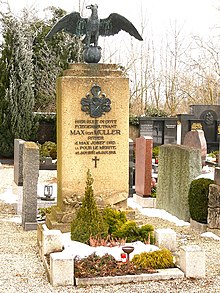Max von Müller (fighter pilot)
Max Müller , posthumously 1919 Ritter von Müller (born January 1, 1887 in Rottenburg an der Laaber , † January 9, 1918 ) was a Bavarian fighter pilot in World War I and knight of the order Pour le Mérite .
Life
He was the eighth child of the trader Max Müller and his wife Margarethe, née Wiesmüller. After completing primary school, he started an apprenticeship with master blacksmith Lechner. Having finished his apprenticeship, he moved around as a journeyman and worked in different places. He was an avid athlete who spent much of his free time doing sports.
Müller joined the 1st Infantry Regiment "König" of the Bavarian Army at the age of 20 and in 1911 he joined the engineering corps. On December 1, 1913, he began training as a pilot in Schleissheim at his own request and, as one of 817 aviation pioneers, obtained his pilot's license (so-called: old eagle ) before the outbreak of the First World War . He was then transferred to the Aviation Department 1 , to which he was a sergeant at the beginning of the war .
The promotion to deputy sergeant major (February 1915) was followed in November of the same year by the appointment as deputy officer . By May 1916 he flew 160 combat missions . After training as single-seaters at the flight school in Mannheim , Müller joined the Single-Seat Combat Command (KEK) "B" on May 18, 1916. He left the Bavarian Air Force at the end of July 1916 and joined Jagdstaffel 2 on September 1, 1916 . On October 10, 1916, he scored his first aerial victory over a British Airco DH2 . On January 21, 1917, he joined the newly founded Jagdstaffel (Jasta) 28 and won more aerial victories. He was promoted to lieutenant on August 26, 1917 . On September 3, 1917, Müller received the order Pour le Mérite and returned to Jasta Boelcke at the end of October . By being awarded the Bavarian Military Max Joseph Order , he was also raised to the personal, non-inheritable nobility and received the title "Knight of". On January 6, 1918 he became a squadron leader. Only three days later he was shot down in his Albatros D.III during an attack on a RE8 near Moorslede in West Flanders . His plane crashed on fire. He didn't survive.
Honorary citizen
Max von Müller made his home town of Rottenburg an der Laaber an honorary citizen on September 23, 1917 . After his death she erected a tomb for him in the mountain cemetery and took care of it. The inscription on his tomb reads:
“Here lies in God pilot lieutenant MAX von MÜLLER, knight of the Max Josef order and Pour le Mérite, born January 1, 1887; † January 9, 1918. "
An eagle watches over the gravestone, on the front of which there is a pilot's helmet with oak leaves; on the back of the grave, the awards of Ritter von Müller can be read. Near the grave is the Müller family grave with a memorial plaque for Max. Rottenburg's main street is also named after him, as is a path in Nuremberg.
Awards
- Iron Cross (1914) 2nd and 1st class
- Cross of the holders of the Royal House Order of Hohenzollern with swords on July 14, 1917
- Pour le Mérite on September 3, 1917
- Pilot badge (Bavaria)
- Silver and Gold Bavarian Bravery Medal
- Knight's Cross of the Military Max Joseph Order
- Golden Württemberg bravery medal
See also
literature
- Peter Pletschacher: The Royal Bavarian Air Force 1912-1919. Stuttgart 1978. ISBN 3-87943-576-6 .
- Arch Whitehouse: Flieger-Ase 1914-1918. Stuttgart 1970.
- Jürgen Brinkmann: The knights of the order Pour le merite 1914-1918. Th. Schäfer Druckerei GmbH. Hanover, Bückeburg 1982.
- Walter Zuerl: Pour le merite-Flieger. Aviation publisher Axel Zuerl. 1987. ISBN 978-3-934596-15-3 .
Web links
Individual evidence
- ^ Bavarian Main State Archives IV ; Digitized copy (war ranking 18152, image 150) from ancestry.com, accessed on December 17, 2019
- ^ Bavarian Main State Archives IV ; Digitized copy (war ranking 18152, image 151) from ancestry.com, accessed on December 17, 2019
- ↑ Peter Pletschacher: The Royal Bavarian Air Force 1912-1919. Stuttgart 1978. ISBN 3-87943-576-6 .
- ↑ Flieger-Ase and U-Boot-Herden: Dispute over Nuremberg's streets on www.nordbayern.de, May 2, 2014
- ↑ a b c d e Jörg Nimmergut: German medals and decorations until 1945, addendum: Anhalt-Deutsches Reich, Register , Central Office for Scientific Order Studies, Munich 2004, ISBN 3-00-001396-2 , p. 119.
| personal data | |
|---|---|
| SURNAME | Müller, Max von |
| ALTERNATIVE NAMES | Müller, Max |
| BRIEF DESCRIPTION | German fighter pilot in the First World War |
| DATE OF BIRTH | January 1, 1887 |
| PLACE OF BIRTH | Rottenburg an der Laaber |
| DATE OF DEATH | January 9, 1918 |
| Place of death | at Moorslede |

